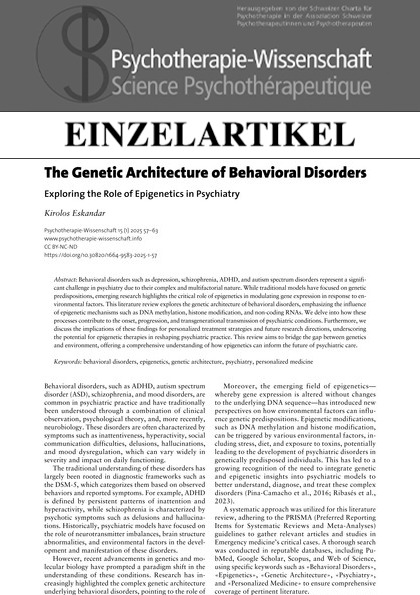The Genetic Architecture of Behavioral Disorders
Exploring the Role of Epigenetics in Psychiatry
DOI:
https://doi.org/10.30820/1664-9583-2025-1-57Keywords:
behavioral disorders, epigenetics, genetic architecture, psychiatry, personalized medicineAbstract
Behavioral disorders such as depression, schizophrenia, ADHD, and autism spectrum disorders represent a significant challenge in psychiatry due to their complex and multifactorial nature. While traditional models have focused on genetic predispositions, emerging research highlights the critical role of epigenetics in modulating gene expression in response to environmental factors. This literature review explores the genetic architecture of behavioral disorders, emphasizing the influence of epigenetic mechanisms such as DNA methylation, histone modification, and non-coding RNAs. We delve into how these processes contribute to the onset, progression, and transgenerational transmission of psychiatric conditions. Furthermore, we discuss the implications of these findings for personalized treatment strategies and future research directions, underscoring the potential for epigenetic therapies in reshaping psychiatric practice. This review aims to bridge the gap between genetics and environment, offering a comprehensive understanding of how epigenetics can inform the future of psychiatric care.
Published
2025-04-03
How to Cite
Eskandar, K. (2025). The Genetic Architecture of Behavioral Disorders: Exploring the Role of Epigenetics in Psychiatry. Psychotherapie-Wissenschaft, 15(1), 57–63. https://doi.org/10.30820/1664-9583-2025-1-57
Issue
Section
Original Work
License
Copyright (c) 2025 Kirolos Eskandar

This work is licensed under a Creative Commons Attribution-NonCommercial-NoDerivatives 3.0 Unported License.
This journal provides open access to its content in accordance with the basic premise that the free public availability of research benefits the exchange of knowledge throughout the world.
Authors wishing to publish in this journal agree to the following:
- The author/s retain/s the copyrights and consent/s to initial publication of the work in the journal under a Creative Commons Attribution licence, which allows third parties to use the work by citing the name/s of the author/s and this journal as initial publisher (in accordance with the Creative Commons Attribution-NonCommercial-NoDerivs 3.0 DE-Licence).
- The author/s can enter into additional contracts for the non-exclusive distribution (e.g. publish in a collection or book) of the version published in the journal, if the journal is cited as initial publisher.


